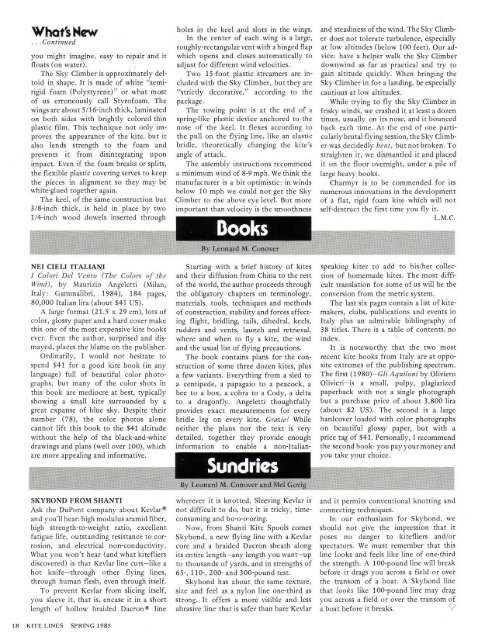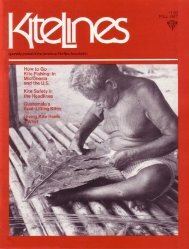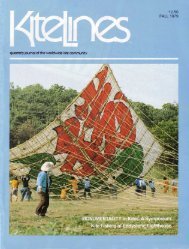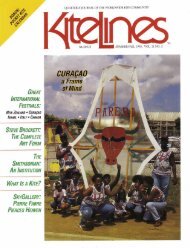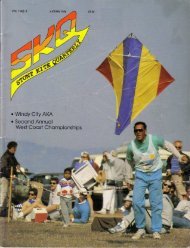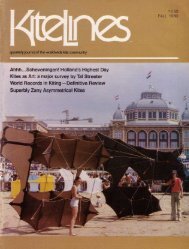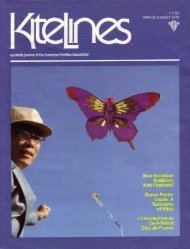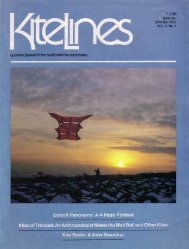Kite Lines - Spring 1985 (Vol. 5 No. 3) - KiteLife
Kite Lines - Spring 1985 (Vol. 5 No. 3) - KiteLife
Kite Lines - Spring 1985 (Vol. 5 No. 3) - KiteLife
You also want an ePaper? Increase the reach of your titles
YUMPU automatically turns print PDFs into web optimized ePapers that Google loves.
you might imagine, easy to repair and it<br />
floats (on water) .<br />
The Sky Climber is approximately deltoid<br />
in shape . It is made of white "semirigid<br />
foam (Polystyrene)" or what most<br />
of us erroneously call Styrofoam . The<br />
wings are about 5/16-inch thick, laminated<br />
on both sides with brightly colored thin<br />
plastic film . This technique not only improves<br />
the appearance of the kite, but it<br />
also lends strength to the foam and<br />
prevents it from disintegrating upon<br />
impact . Even if the foam breaks or splits,<br />
the flexible plastic covering serves to keep<br />
the pieces in alignment so they may be<br />
white-glued together again .<br />
The keel, of the same construction but<br />
3/8-inch thick, is held in place by two<br />
1/4-inch wood dowels inserted through<br />
holes in the keel and slots in the wings .<br />
In the center of each wing is a large,<br />
roughly-rectangular vent with a hinged flap<br />
which opens and closes automatically to<br />
adjust for different wind velocities .<br />
Two 15-foot plastic streamers are included<br />
with the Sky Climber, but they are<br />
"strictly decorative," according to the<br />
package .<br />
The towing point is at the end of a<br />
spring-like plastic device anchored to the<br />
nose of the keel . It flexes according to<br />
the pull on the flying line, like an elastic<br />
bridle, theoretically changing the kite's<br />
angle of attack .<br />
The assembly instructions recommend<br />
a minimum wind of 8-9 mph . We think the<br />
manufacturer is a bit optimistic : in winds<br />
below 10 mph we could not get the Sky<br />
Climber to rise above eye level . But more<br />
important than velocity is the smoothness<br />
and steadiness of the wind . The Sky Climber<br />
does not tolerate turbulence, especially<br />
at low altitudes (below 100 feet) . Our advice<br />
: have a helper walk the Sky Climber<br />
downwind as far as practical and try to<br />
gain altitude quickly . When bringing the<br />
Sky Climber in for a landing, be especially<br />
cautious at low altitudes .<br />
While trying to fly the Sky Climber in<br />
frisky winds, we crashed it at least a dozen<br />
times, usually on its nose, and it bounced<br />
back each time . At the end of one particularlybrutal<br />
flying session, the Sky Climber<br />
was decidedly bent, but not broken . To<br />
straighten it, we dismantled it and placed<br />
it on the floor overnight, under a pile of<br />
large heavy books .<br />
Charmyr is to be commended for its<br />
numerous innovations in the development<br />
of a flat, rigid foam kite which will not<br />
self-destruct the first time you fly it .<br />
L .M .C .<br />
NEI CIELI ITALIANI<br />
I Colori Del Vento (The Colors of the<br />
Wind), by Maurizio Angeletti (Milan,<br />
Italy : Gammalibri, 1984), 184 pages,<br />
80,000 Italian lira (about $41 US) .<br />
A large format (21 .5 x 29 cm), lots of<br />
color, glossy paper and a hard cover make<br />
this one of the most expensive kite books<br />
ever. Even the author, surprised and dismayed,<br />
places the blame on the publisher .<br />
Ordinarily, I would not hesitate to<br />
spend $41 for a good kite book (in any<br />
language) full of beautiful color photographs,<br />
but many of the color shots in<br />
this book are mediocre at best, typically<br />
showing a small kite surrounded by a<br />
great expanse of blue sky . Despite their<br />
number (78), the color photos alone<br />
cannot lift this book to the $41 altitude<br />
without the help of the black-and-white<br />
drawings and plans (well over 100), which<br />
are more appealing and informative .<br />
Starting with a brief history of kites<br />
and their diffusion from China to the rest<br />
of the world, the author proceeds through<br />
the obligatory chapters on terminology,<br />
materials, tools, techniques and methods<br />
of construction, stability and forces affecting<br />
flight, bridling, tails, dihedral, keels,<br />
rudders and vents, launch and retrieval,<br />
where and when to fly a kite, the wind<br />
and the usual list of flying precautions .<br />
The book contains plans for the construction<br />
of some three dozen kites, plus<br />
a few variants . Everything from a sled to<br />
a centipede, a papagaio to a peacock, a<br />
bee to a box, a cobra to a Cody, a delta<br />
to a dragonfly. Angeletti thoughtfully<br />
provides exact measurements for every<br />
bridle leg on every kite . Grazie! While<br />
neither the plans nor the text is very<br />
detailed, together they provide enough<br />
information to enable a non-Italianspeaking<br />
kiter to add to his/her collection<br />
of homemade kites . The most difficult<br />
translation for some of us will be the<br />
conversion from the metric system .<br />
The last six pages contain a list of kitemakers,<br />
clubs, publications and events in<br />
Italy plus an admirable bibliography of<br />
38 titles . There is a table of contents, no<br />
index .<br />
It is noteworthy that the two most<br />
recent kite books from Italy are at opposite<br />
extremes of the publishing spectrum .<br />
The first (1980)-Gli Aquiloni by Oliviero<br />
Olivieri-is a small, pulpy, plagiarized<br />
paperback with not a single photograph<br />
but a purchase price of about 3,800 lira<br />
(about $2 US) . The second is a large<br />
hardcover loaded with color photographs<br />
on beautiful glossy paper, but with a<br />
price tag of $41 . Personally, I recommend<br />
the second hook : you pay your money and<br />
you take your choice .<br />
SKYBOND FROM SHANTI<br />
Ask the DuPont company about Kevlar ®<br />
and you'll hear : high modulus aramid fiber,<br />
high strength-to-weight ratio, excellent<br />
fatigue life, outstanding resistance to corrosion,<br />
and electrical non-conductivity .<br />
What you won't hear (and what kitefliers<br />
discovered) is that Kevlar line cuts-like a<br />
hot knife-through other flying lines,<br />
through human flesh, even through itself .<br />
To prevent Kevlar from slicing itself,<br />
you sleeve it, that is, encase it in a short<br />
length of hollow braided Dacron® line<br />
wherever it is knotted . Sleeving Kevlar is<br />
not difficult to do, but it is tricky, timeconsuming<br />
and bo-o-o-oring .<br />
<strong>No</strong>w, from Shanti <strong>Kite</strong> Spools comes<br />
Skybond, a new flying line with a Kevlar<br />
core and a braided Dacron sheath along<br />
its entire length-any length you want-up<br />
to thousands of yards, and in strengths of<br />
65-, 110-, 200- and 300-pound test .<br />
Skybond has about the same texture,<br />
size and feel as a nylon line one-third as<br />
strong . It offers a more visible and less<br />
abrasive line that is safer than bare Kevlar<br />
and it permits conventional knotting and<br />
connecting techniques .<br />
In our enthusiasm for Skybond, we<br />
should not give the impression that it<br />
poses no danger to kitefliers and/or<br />
spectators . We must remember that this<br />
line looks and feels like line of one-third<br />
the strength . A 100-pound line will break<br />
before it drags you across a field or over<br />
the transom of a boat . A Skybond line<br />
that looks like 100-pound line may drag<br />
you across a field or over the transom of<br />
a boat before it breaks . I/


